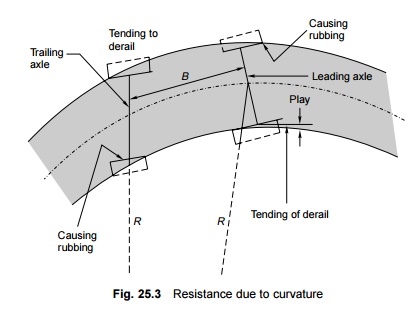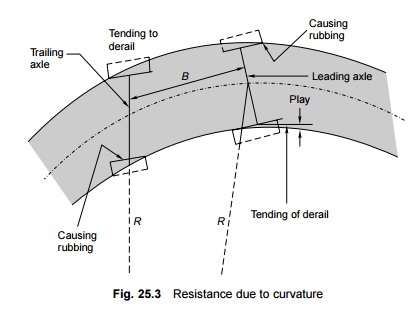Chapter: Civil : Railway Airport Harbour Engineering : Railway Engineering : Train Resistance and Tractive Power
Train Resistance Due to Curvature

Various forces offer resistance
to the movement of a train on the track. These resistances may be a result of
the movement of the various parts of the locomotives as well as the friction
between them, the irregularities in the track profile, or the atmospheric
resistance to a train moving at great speed. The tractive power of a locomotive
should be adequate enough to overcome these resistances and haul the train at a
specified speed.
Resistance Due to Curvature
When a train negotiates a
horizontal curve, extra effort is required to overcome the resistance offered
by the curvature of the track. Curve resistance is caused basically because of
the following reasons (Fig. 25.3).
The vehicle cannot adapt itself to a curved track because of
its rigid wheel base. This is why the frame takes up a tangential position as
vehicle tries to move in a longitudinal direction along the curve as shown in
Fig. 25.3. On account of this, the flange of the outer wheel of the leading
axle rubs against the inner face of the outer rail, giving rise to resistance
to the movement of the train.

(b) Curve
resistance can sometimes be the result of longitudinal slip, which causes the
forward motion of the wheels on a curved track. The outer wheel flange of the
trailing axle remains clear and tends to derail. The position worsens further
if the wheel base is long and the curve is sharp.
(c) Curve
resistance is caused when a transverse slip occurs, which increases the
friction between the wheel flanges and the rails.
(d) Poor
track maintenance, particularly bad alignment, worn out rails, and improper
levels, also increase resistance.
(e) Inadequate
superelevation increases the pressure on the outer rail and, similarly, excess
superelevation puts greater pressure on the inner rails, and this also
contributes to an increase in resistance.
The value of curve resistance can be determined by the
following equation:
Curve resistance = C . FG/R
where F is the force of
sliding friction, G is the gauge of the track, R is the mean radius
of the curve, and C is the constant, which is dependent on various
factors. This equation indicates that
(a) curve
resistance increases with increase in gauge width and
(b) resistance
is inversely proportional to the radius, i.e., it increases with an
increase
in the degree of the curve.
Empirical formulae have been worked out for curve resistance,
which are as follows:
Curve resistance for BG (R5) = 0.0004WD (25.7)
Curve resistance for MG (R5) = 0.0003WD (25.8)
Curve resistance for NG (R5) = 0.0002WD (25.9)
where W is the weight of
the train in tonnes and D is the degree of the curve. It means that for
a 4 o curve on a BG line, the curve resistance for a train weighing 250 t would
be 0.0004 × 250 × 4 = 0.4 t.
Compensated gradient for curvature
Curve resistance is quite often
compensated or offset by a reduction in the gradient. In this way, the effect
of curve resistance is translated in terms of resistance due to gradient. The
compensation is 0.04% on BG, 0.03% on MG, and 0.02% on NG lines for every 1 o of
the curve. This will be clear through the solved example given below.
Example 25.1 Calculate
the compensated gradient on a BG track with a 4 o curvature on a ruling
gradient of 1 in 200.
Solution
Ruling gradient = 1 in 200 = 0.5% Compensation for curvature =
0.04 × 4 = 0.16%
Compensated
gradient = 0.05 - 0.16 = 0.34% = 1 in 294
Special characteristics of curve
resistance
Certain characteristics of curve
resistance have been observed over the years. These are enumerated here.
(a) Curve
resistance increases with the speed of the train.
(b) Curve
resistance depends upon the central angle of the curve. For example, if there
are two curves of different radii, but with the same central angle, the total
curve resistance would be the same.
(c) Though
curve resistance depends on the weight of the train, the length of the train
has no appreciable effect on it.
(d) Curve
resistance is less with new rails compared to that with old rails.
Depending upon various factors, curve resistance can be as low
as 0.20 kg per tonne per degree curve when the track is in good condition and
may go as high as 1.0 kg per tonne per degree curve for worn out rails, rough
tracks, and other unfavourable conditions of the track.
Related Topics